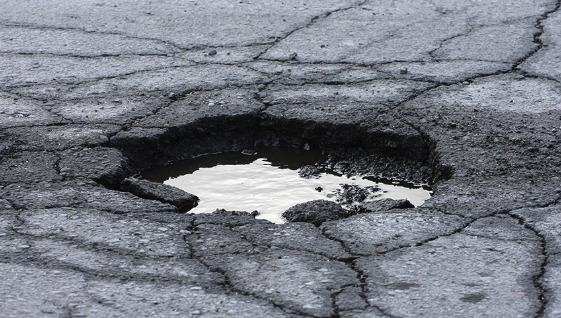The Cheapest Ways to Fill Potholes

Potholes are a common and frustrating problem on many roads and driveways, and they can cause damage to vehicles and create safety hazards for pedestrians. Repairing potholes is typically a job for local authorities or professional paving companies, but if you’re dealing with a small pothole on a private driveway or a low-traffic road, you may consider a DIY approach to save money. In this guide, we will explore some of the cheapest ways to fill potholes on your own.
Why Repair Potholes Yourself?
Before delving into DIY pothole repair methods, it’s important to understand the advantages and limitations of tackling this task on your own:
Advantages:
- Cost Savings: DIY pothole repair can save you money compared to hiring a professional paving company.
- Timely Fix: You can address potholes as soon as they appear, preventing them from worsening and causing more significant damage.
- Learning Experience: Repairing potholes can be a valuable DIY skill, and it can be a satisfying project for those who enjoy hands-on work.
Limitations:
- Durability: DIY pothole repairs may not be as long-lasting as professional repairs, especially in high-traffic areas.
- Safety: Be aware that improper pothole repair can create safety hazards if not done correctly.
- Materials and Tools: You will need access to suitable materials and tools, which may require an initial investment.
Now, let’s explore some of the cheapest DIY methods to fill potholes:
1. Cold Mix Asphalt Patch
Materials Needed:
- Cold mix asphalt patch (readily available at home improvement stores)
- Shovel
- Tamper or hand compactor
- Safety gear (gloves and safety glasses)
Steps:
- Start by cleaning the pothole of loose debris, dirt, and water.
- Fill the pothole with the cold mix asphalt patch material. Overfill it slightly to account for compaction.
- Compact the material using a tamper or hand compactor, ensuring it is level with the surrounding surface.
- Tamp down the patched area repeatedly until it is firmly packed and even with the rest of the pavement.
Cold-mix asphalt patches are relatively inexpensive and readily available. They can be used for small to medium-sized potholes and provide a durable solution for minor repairs.
2. Gravel or Crushed Stone
Materials Needed:
- Gravel or crushed stone (appropriate size and type for your pothole)
- Shovel
- Tamper or hand compactor
Steps:
- Clear the pothole of loose debris, dirt, and water.
- Fill the pothole with gravel or crushed stone, slightly overfilling it.
- Compact the material using a tamper or hand compactor until it is firmly packed and leveled with the surrounding surface.
Using gravel or crushed stone can be a cost-effective way to fill smaller potholes, but keep in mind that it may not provide a smooth or long-lasting surface, especially in areas with heavy traffic.
3. Concrete Mix
Materials Needed:
- Quick-setting concrete mix
- Shovel
- Tamper or hand compactor
- Water (for mixing)
Steps:
- Clean the pothole and remove any loose debris or dirt.
- Mix the quick-setting concrete according to the manufacturer’s instructions.
- Fill the pothole with the concrete mix, slightly overfilling it.
- Compact the concrete using a tamper or hand compactor.
- Finish the surface with a trowel or float to ensure it is level with the surrounding pavement.
Quick-setting concrete can be a durable and cost-effective solution for small to medium-sized potholes. It sets quickly, allowing for a relatively fast repair.
4. Sand and Patching Compound
Materials Needed:
- Sand
- Patching compound (e.g., asphalt patch or concrete patch)
- Trowel
- Tamper or hand compactor
Steps:
- Clear the potholes of debris and dirt.
- Fill the pothole with a layer of sand to within a couple of inches of the surface.
- Apply a layer of patching compound (asphalt or concrete, depending on your surface) on top of the sand, slightly overfilling the pothole.
- Compact the patching compound using a tamper or hand compactor.
- Finish the surface with a trowel to make it level with the surrounding pavement.
This method provides an inexpensive way to fill shallow potholes and can be effective for minor repairs.
5. Recycled Materials
If you have access to recycled asphalt or recycled concrete, these materials can be a cost-effective way to fill potholes. The process is similar to using gravel or crushed stone, where you fill the pothole with recycled material and compact it until it’s level with the surrounding surface.
6. Temporary Solutions
For a quick and temporary fix, consider using materials like sand or cold patch asphalt to fill potholes until you can arrange a more permanent repair. While not a long-term solution, this can help prevent further damage to your vehicle and create a safer surface.
Safety Precautions
When attempting DIY pothole repair, it’s essential to take safety precautions:
- Wear appropriate safety gear, including gloves and safety glasses, to protect yourself from debris and dust.
- Work in a well-ventilated area to avoid inhaling fumes from patching materials.
- Follow manufacturer instructions for any materials you use.
- Use caution when compacting materials, as this can be physically demanding work.
When to Seek Professional Help
While DIY methods can be cost-effective for small potholes and minor repairs, there are situations where professional help is necessary:
- Large Potholes: If the pothole is exceptionally large or deep, it’s best to consult with a professional to assess the extent of the damage and recommend appropriate repairs.
- High-Traffic Areas: Potholes in high-traffic areas may require more robust and durable repairs that professionals can provide.
- Complex Issues: If you suspect underlying issues like drainage problems or compromised sub-base, it’s advisable to consult with experts who can address these issues.
- Safety Concerns: If the pothole poses a safety hazard to pedestrians or vehicles, it should be repaired promptly and professionally.
In conclusion, DIY pothole repair can be a cost-effective solution for minor damage on your property. However, it’s essential to evaluate the size and location of the pothole, consider safety precautions, and use suitable materials for the repair. For larger or more complex potholes or those in high-traffic areas, consulting with a professional paving company is often the safest and most effective option. Ultimately, the goal is to ensure a safe and smooth surface for your driveway or road while minimizing costs and inconvenience.
Contact us
 Phone Call |
 Text Message |
 |







